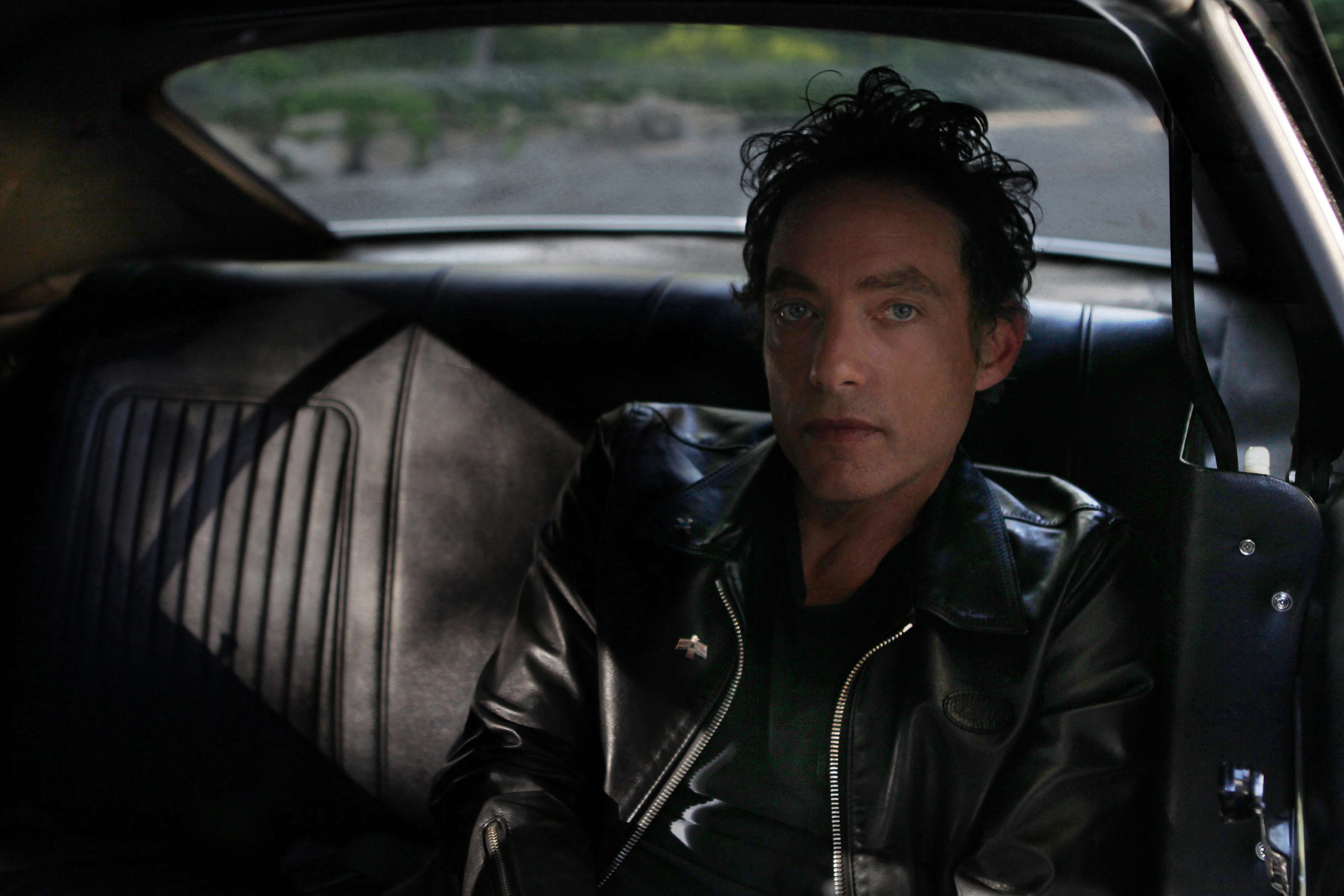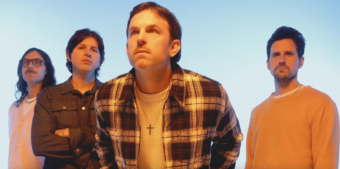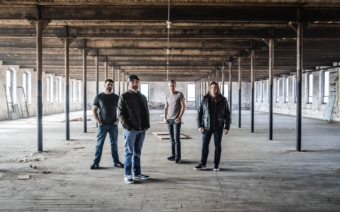“It’s daunting because you’re starting over every time,” says The Wallflowers’ Jakob Dylan.
“You check in and ask yourself, ‘Am I ready to do this?’ It’s not a matter of success or not. It’s another record that I have to write and turn myself inside out for — and then, hopefully, make the record, and then talk about it and tour it.”
Seated in the lobby of a Santa Monica hotel, the singer-songwriter is drinking an iced black coffee on a sweltering hot June day. He’s here to discuss Exit Wounds, his band’s soon-to-be-released seventh record — and The Wallflowers’ first in nine years. Dylan’s distinctive bright blue eyes are accentuated by his denim button-down shirt. His sleeves are rolled up, as are the bottoms of his loose-fitting jeans, with the only color deviation being his yellow Vans sneakers and olive green Leiper’s Fork Market baseball cap. As of late, Dylan’s been busy making the promotional rounds: doing media and radio interviews, playing on late-night TV talk shows.
It’s a grueling schedule — but Exit Wounds, a stunning body of work by anyone’s standards, would seem to be worth the grind. The album is organic and rich, with Dylan’s deep, smoky voice mixed high above layers of guitars and keyboards. Its songs draw you in more closely with each listen, hearkening back to an era before digital singles and streaming — when people sat and listened to records in full. In many ways, The Wallflowers’ enduring rock is out of fashion with the ebb and flow of modern pop trends. But maybe in part for that reason, it has rarely sounded more satisfying.
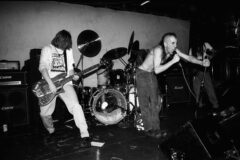
Also Read
30 Overlooked 1992 Albums Turning 30
Lead single “Roots And Wings,” released in April, was immediately embraced by radio: holding strong at No. 1 on Americana for weeks and cracking the AAA top 10. It’s a lyrically pointed rocker about a tutelage that ended badly, with Dylan singing, “I showed you how to swing / I showed you how to strut / That’s my mojo you’re using / That’s my wine getting you drunk.”
There was a time when The Wallflowers delivered similarly tuneful, character-driven songs with some regularity. Not lately: A seven-year gap separated 2005’s Rebel, Sweetheart and 2012’s Glad All Over, and now it’s been just shy of a decade since that record. Dylan says that, to some degree, he lost track of time. But he doesn’t feel the same pressure to release records that he felt earlier in his career, relying instead on genuine motivation.
“When you get started, you feel you’re going to lose traction and it will all slip away if you don’t keep maintaining it,” he says. “That phase passes at some point, and then you have a career, and you can make records when you’re inspired.”
Nonetheless, Dylan’s been working steadily all along. The Wallflowers tour consistently every summer (barring 2020, of course, due to the pandemic) and Dylan spent almost four years working on 2018’s Echo in the Canyon. That project, a music documentary written and directed by Dylan’s longtime manager Andrew Slater, explores the musical ideas reverberating throughout Laurel Canyon in the mid-’60s — and their transcendent influence on the next generation of artists. Dylan executive-produced the film and appeared interviewing a variety of music legends, including the Byrds’ Roger McGuinn and the Beach Boys’ Brian Wilson. (He also performed on the Slater-produced soundtrack, singing duets of popular mid-’60s covers with guest vocalists like Beck and Fiona Apple.)
Unfortunately, Echo in the Canyon’s bright, shining sun set before the start of Exit Wounds. A cataclysmic cultural shift occurred after work began on the documentary, crescendoing with an unprecedented darkness: A grim era of political turmoil and a brutal pandemic defined the world several years later.
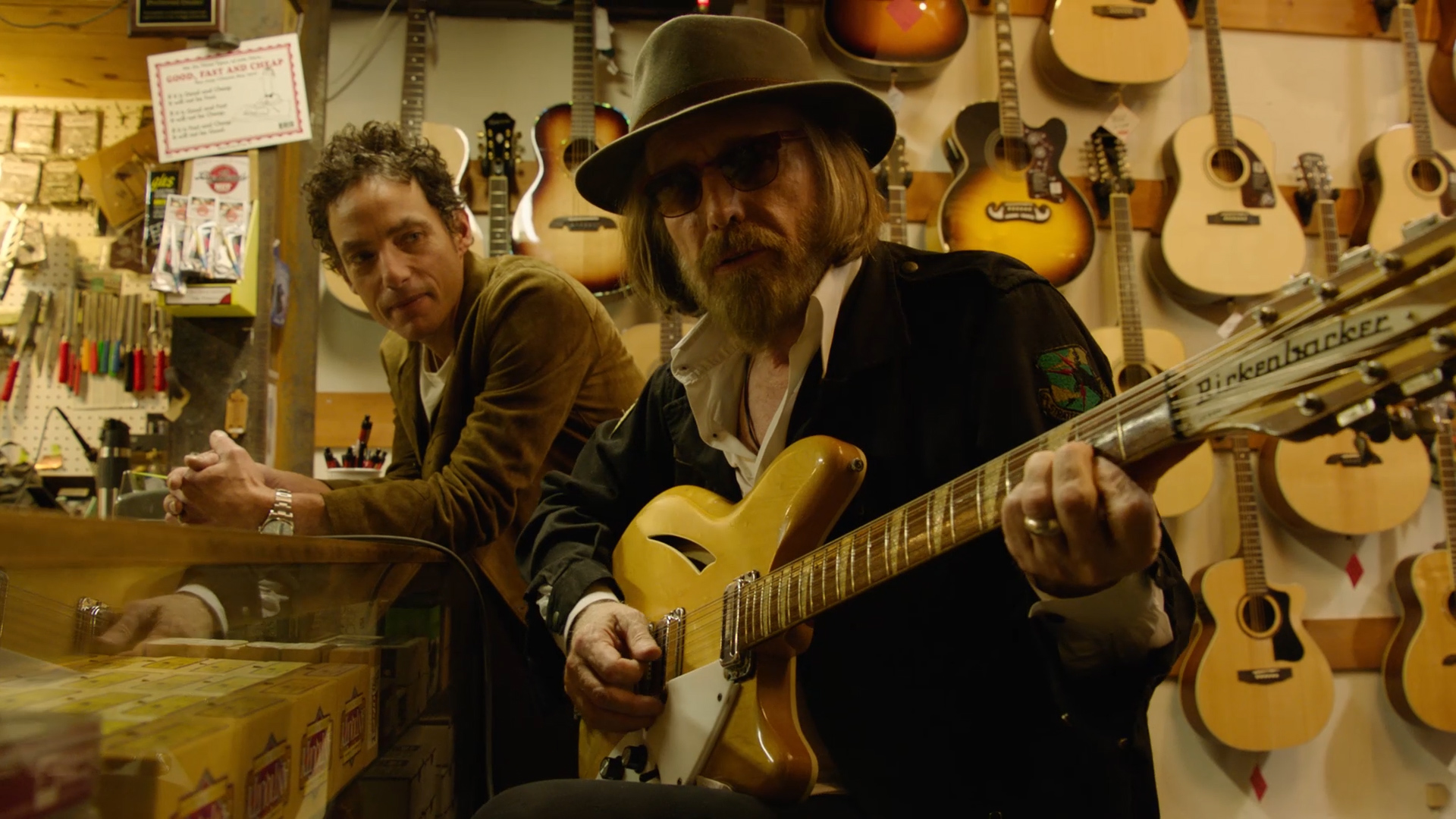
Dylan actually wrote Exit Wounds before the COVID-19 crisis and finished recording it over a year ago, but he held back its release — he couldn’t enjoy putting out an album during a time of such suffering. (He did, however, conceive the album’s title during the height of the pandemic.) Now, on the verge of releasing these songs into a world desperate for healing, he says, “We all have exit wounds as much as ever. Whether we’re going to a better place or making a lateral move, we can’t get there from here without them.”
But Dylan was already navigating transitions of his own following Glad All Over, which marked the end of his recording contract with Columbia Records. He looked for a new record deal, but labels wanted to hear material first. Dylan says he doesn’t take it personally, but he’s not looking to work with anyone focused on what’s commercially lucrative — or on a single song instead of a collection.
At this point in his career, Dylan is not inclined to “audition.”
“I’m not a kid. You know what I do,” he says. “Check me out. Go to YouTube or whatever. I always hope to make the best version of that. But pitch you songs? No, I’m too far along to try to please anybody in an office.”
Instead, Dylan paid for Exit Wounds himself, signing a two-record licensing deal with Nashville-based indie label New West Records. “That’s what I want to do from here on out,” he says. “As a template for work, I think that makes a lot more sense. When you’re on a label, and you have a five-record deal, and you’re not happy with each other after the third record, there’s no point anyway.”
But there were other significant changes following the last album, when longtime The Wallflowers bassist Greg Richling retired from touring and keyboardist Rami Jaffee joined Foo Fighters, after being a session player and touring with them for years.
Glad All Over was made after a seven-year band hiatus, preceded by years of ongoing friction. And Dylan’s desire for a harmonious reconciliation quickly turned to disillusionment — reuniting in the recording studio only served to restore the group’s long-standing unresolved tension.
“Bands take breaks all the time, and then most of the stuff that caused you to take your break dissipates,” he says. “You forget about it and only remember the good stuff. And, like a lot of people, we got back together and we didn’t really talk about those issues.
“I really wanted it to work, but there was just no way,” he adds. “The energy of Glad All Over was contentious from day one, and when I say ‘contentious,’ I don’t mean arguments. I mean stone-cold silence and weirdness. That’s worse.”
Dylan hears the band’s strained relationship when he listens to the record, and beyond high points — like the stellar “Love is a Country,” and the Mick Jones-featured “Reboot the Mission,” a nod to one of Dylan’s favorite bands, The Clash — he was disappointed by other songs, including “The Devil’s Waltz.” “It was very frustrating to me,” he says. “I thought there were some good points on the record, but it was very fractured.”
Fueled by a combination of lingering dissatisfaction and fresh inspiration, Dylan was keen to restore The Wallflowers’ legacy and bring it full circle, bookending the original, unadulterated spirit with which he founded his band.
“After all it’s been through and how long I’ve worked on it, and the mess it’s been at times, I needed to claim it,” he says. “It was important for me to make a pure Wallflowers record. I started this band. This is my band. It doesn’t matter who is or who isn’t around anymore.”
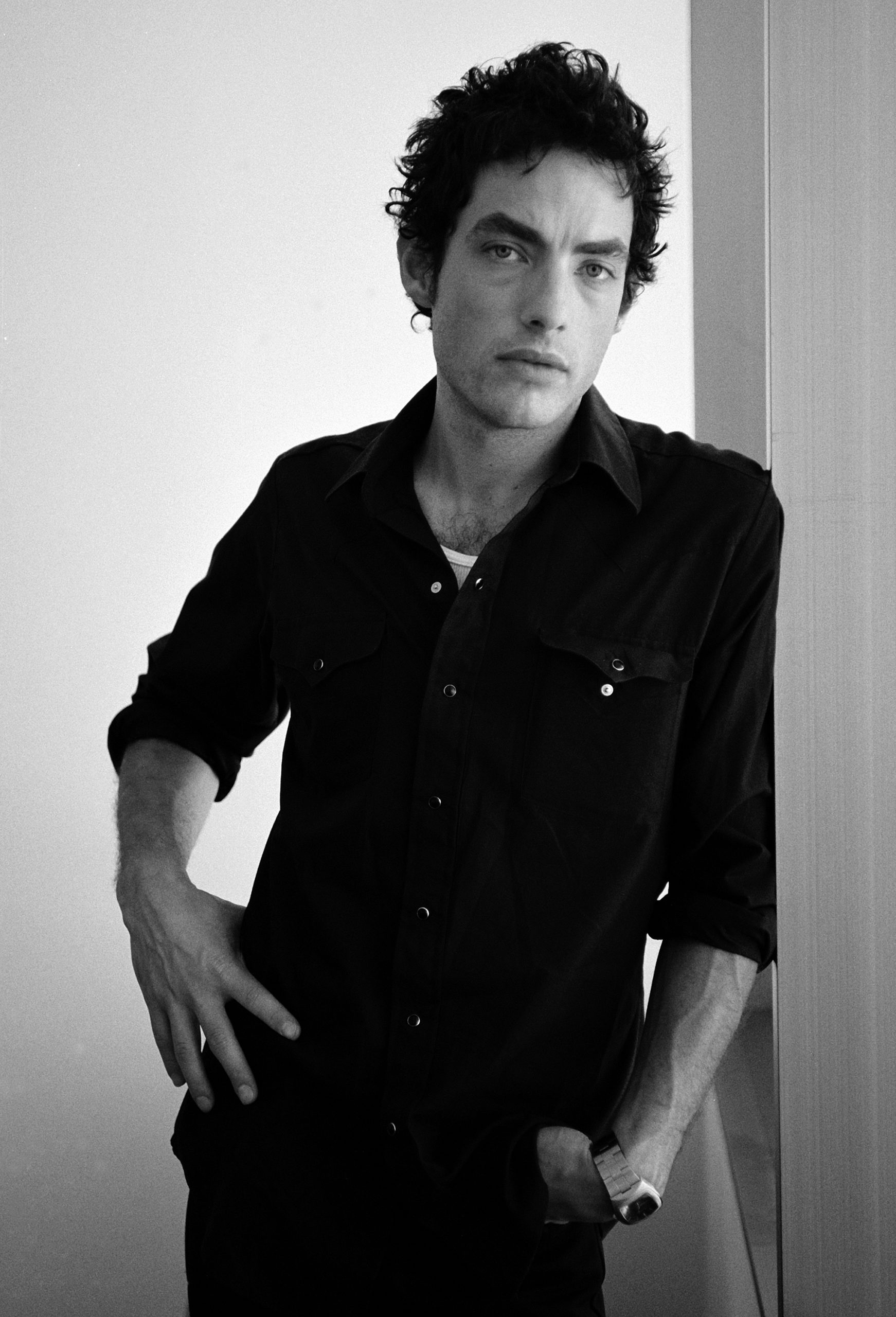
Following a summer tour in 2019, Dylan began writing songs on guitar and piano. He also sparked ideas during long outdoor walks, recording voice notes and typing out lyrics on his cell phone. “I write most of my stuff walking. It keeps ideas swirling in your brain,” he says. “When you’re writing songs sitting in a chair and looking at a wall, you can get stifled. You have to do that work too, but moving is good.”
As an avid reader, words are of profound importance to Dylan. He routinely jots down notes here and there, but he doesn’t fully open the writing vein until he’s ready to make a record. At that point, he becomes completely fixated: crafting his lyrics meticulously, repeatedly editing and re-editing, constantly scrutinizing his rhyme schemes, poring over how his lyrics look typed across the page.
“It will totally consume you, and you’re not really nice to be around,” he says. “You’re there, but you’re not. You’re listening, but you’re not. You’re always stuck on the one word you’re looking for.”
His fastidiousness even prevents him from enjoying his own company. “I drive myself crazy, and I’m not happy about it,” he says. “But maybe, in the end, it’s an asset. Maybe to someone who likes my work and what I do, it matters.” He shakes his head and bursts out laughing: “I fucking hope it matters.”
“Jakob’s a lyric guy, and he’s particular,” says Exit Wounds producer Butch Walker, seated on a couch in the lounge of his Santa Monica-based recording studio, RubyRed Productions. “He would edit after the song was done. He’d go back in and want to replace one word here and one word there, because he thought it would confuse the lyric if he didn’t. That’s respectable.”
In over two decades, it was Walker’s first time agreeing to produce a record without needing to hear songs first. “I’ve always been a fan of Jakob’s records and his songwriting, and his voice is one of my favorites in music,” he says. “So I took a gamble, knowing that I would love making it, and that it would be better than most artists’ best work.”
Dylan recruited Walker not only for his savvy production skills, but also because his longtime friend is an established singer-songwriter. “It works best for me to work with someone who does my job, walks my street, and knows how to put a song together,” says Dylan. ”When I’m sweating a lyric, I want that person to understand that it means a lot to me.”
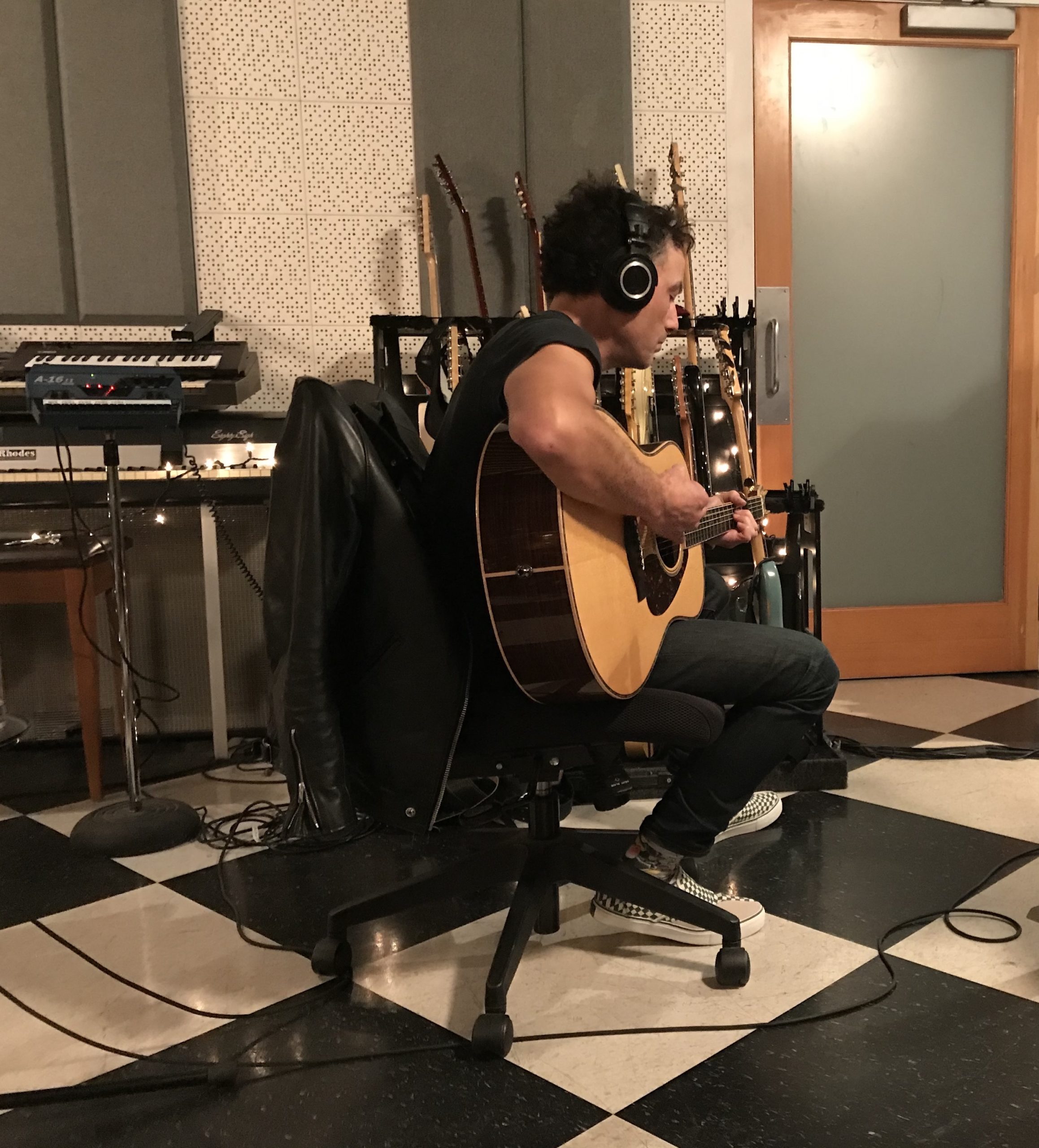
Walker also played on the album, contributing guitar, keyboard, percussion and some backing vocals. Elsewhere, Exit Wounds features a mix of fresh and familiar faces, with Dylan (guitar, vocals) joined by Mark Stepro (drums), Brian Griffin (drums on one track), Whynot Jansveld (bass, mastering), Aaron Embry (keyboards), singer-songwriter Shelby Lynne (vocals) and guitarist Val McCallum (who previously appeared on 2002’s Red Letter Days).
“It sounds like The Wallflowers because I know how to do that,” says Dylan, referring to his new lineup. “It’s a sound I’ve cultivated for 30 years. I know how to instruct people where it goes — if they’re good musicians and listening, not worrying about overthinking their parts too much.”
That well-cultivated sound remains intact on Exit Wounds. Like always, Dylan’s rich metaphorical imagery beautifully illustrates the fallibility of the human condition, and the vicissitudes of human connection. Even the LP’s bleakest moments are underscored by tenderness and fragility, with Dylan mitigating the darkness wherever possible: “It’s never felt good to me to write a song that feels like it’s dire and a trap,” he says. “I always want to see a light at the end of the tunnel.”
In the heart-stirring ballad “I’ll Let You Down (But Will Not Give You Up),” featuring Lynne on backing vocals, a stranded and dilapidated vehicle symbolizes a troubled relationship that’s long veered off course to the point of disrepair. But Dylan’s stark portrayal serves to accent the power of unwavering commitment, as he repeatedly sings, “I’ll let you down, but I will not give you up.”
On the galvanizing, politically-inspired rocker “Move The River,” Dylan highlights the necessity of transcending unbearable circumstances. “You’re gonna want to get your lamp lit,“ he sings, “It’s not as dark as it’s gonna get / And we’re a long way from higher ground …There’s no way around it / However you feel about it / We’re gonna move the river.”
One future concert crowd-pleaser is “Who’s That Man Walking ‘Round My Garden,” a lively homage to Tom Petty. The song, in which a character grows increasingly vigilant trying to defend his property from a persistent intruder, underlines the importance of protecting what you love. “I’m counting sheep, and I’m taking names / I’m locked and loaded, both night and day,” he sings. “Under my nose the lock is off the chain / Tell me, who’s that man walking around my garden?”
Dylan says Petty’s influence resonates throughout Exit Wounds. The two spent time together before the latter’s untimely 2017 death, including Petty’s last ever on-camera interview for Echo in the Canyon.
“‘Who’s That Man’ is a straight-up tribute to Tom Petty, his music, and his style, and I hope he notices somewhere,” says Dylan. “I can’t say enough about his positivity and encouragement. It was very moving to have him pass, and it affected me greatly, so there are moments of not just influence, but a tip of my hat in appreciation that I hope he’ll hear.”
Populated by characters, Dylan’s largely abstract songs switch tenses and perspectives, but the sentiments are direct — and sometimes he’s the “you” being addressed in his lyrics. “I’m in every song,” he says. “They come from me and I always try to find a way to be as honest and introspective as possible. But you’re also writing music so other people will want to listen to it, whether they care about you personally, or your story, or not, so you’re trying to make a vignette of different characters, and you’re probably one of them. A lot of the time, it sounds like you’re talking to someone else, but you’re talking to yourself.”
Mostly, Dylan prefers to let his songs stand on their own, without elucidation, but not because he’s being evasive or hiding anything. “For me, it’s never been important to give cheat sheets or CliffsNotes as to what songs are about,” he says. “It brushes off the magic of a song to explain it. They are collages, and they have a through-line, and all the phrases dance around the central theme. You can’t always summarize them in two sentences. If I have to explain it, then I probably didn’t do a good job writing the song.”
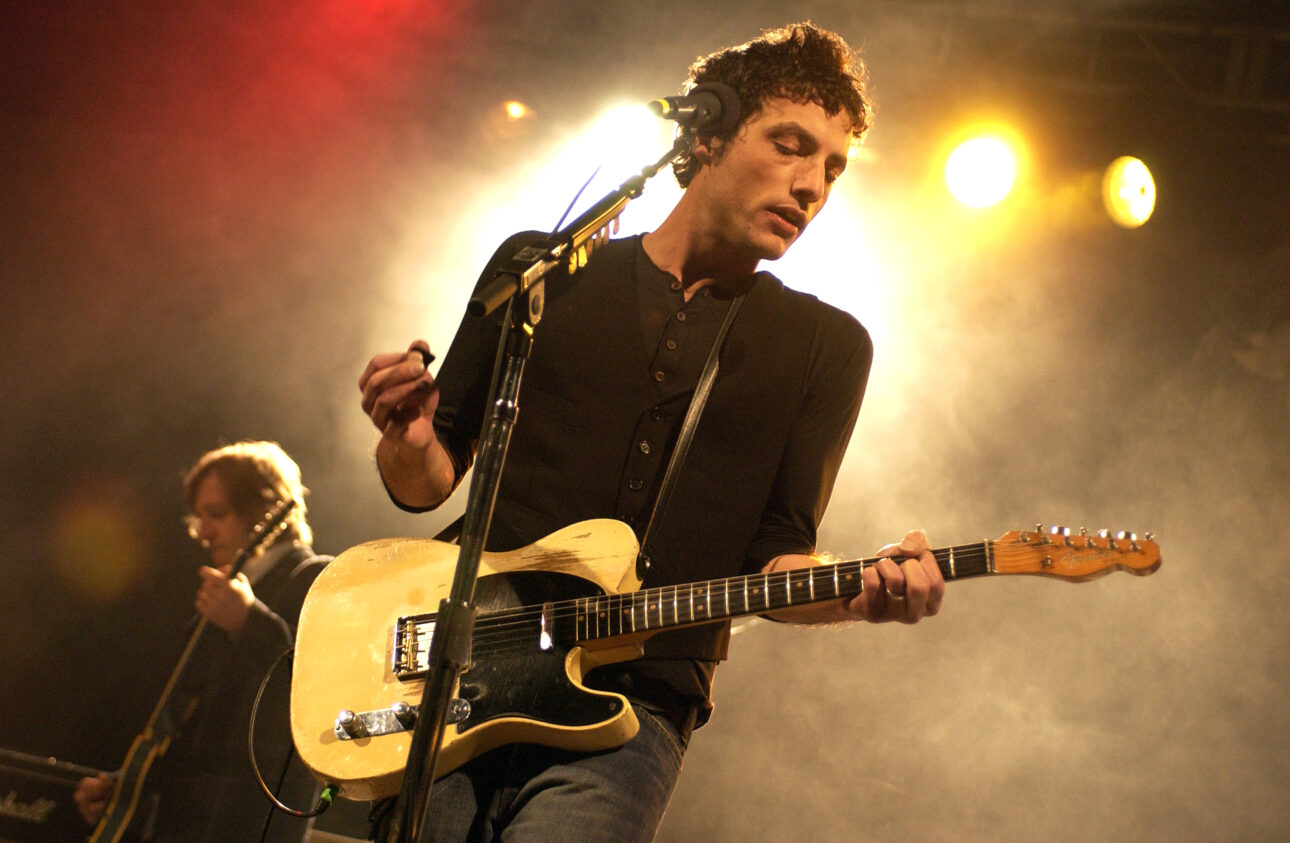
At 51, Dylan has been a singer-songwriter for well over half his life. But he started out as a guitarist in The Bootheels, a rock band he founded in the late ‘80s with Tobi Miller, a friend since seventh grade. “I wasn’t blowing anybody away with my guitar,” he says. “But it was a way to be in a band and see what it was like and to learn.”
Dylan knew he’d eventually become a singer-songwriter. But time in The Bootheels allowed him to develop his craft privately, mindful of the inevitable pitfalls of stepping out in front of a microphone on stage — beneath not just the literal glare of the spotlight, but also the amplified wattage from the high expectations of being Bob Dylan’s son.
“I was always acutely aware that I didn’t want to figure this out in front of people,” he says. “Because I knew it was obviously going to be scrutinized at an unnecessary level, so I should at least be confident.”
When The Bootheels broke up after only six months, 18-year-old Dylan set aside music, leaving Los Angeles to attend New York’s Parsons School of Design — where he quickly realized his preference for painting pictures, not with brushes and pigments, but with lyrics and music. So Dylan promptly dropped out of art school and returned to the west coast, reconnecting with Miller.
Together, they founded a four-piece rock band, The Apples, fronted by Dylan and driven by his songs, with drummer Peter Yanowitz and bassist Barrie Maguire rounding out the lineup. Soon after, they changed their name to The Wallflowers.
Dylan purposefully avoided contemplating the magnitude of following in his iconic father’s footsteps. “I didn’t allow myself to think about it,” he says, “Because I knew the answer would be, ‘You’re out of your fucking mind. You shouldn’t do that.’”
Instead, Dylan followed his own path. “I was getting better at songwriting and I thought, ‘Why don’t I deserve to do what I like to do as much as anybody else?’” he says. “I was the one who had to live and die with the consequences, and I was up for it, so why not?”
That drive was vital to the band’s early days in L.A.: playing local clubs, recording and shopping song demos (featuring keyboardist Mark Ramos-Nishita, a.k.a. “Money Mark”). The hustle led to a contract with Virgin Records, and with Jaffee now on keys, The Wallflowers released their self-titled debut in 1992.
Dylan’s versatility was obvious, even at this early stage: Songs like “Hollywood,” “Ashes to Ashes” and “For The Life Of Me” showcased a strong melodic sense and insightful lyrics that reflected wisdom beyond his years. The Wallflowers also previewed their commercial potential, selling a respectable 40,000 copies — but as often happens in the ephemeral music industry, Virgin Records founders and co-chairmen Jeff Ayeroff and Jordan Harris resigned in 1993. As the two were the raison d’être for Dylan signing with the label, he asked for The Wallflowers to be released from their contract.
Still, it wasn’t back to the drawing board entirely. There was a song Dylan held off the first record, a sharp display of his well-honed songwriting: the bluesy and poetic “6th Avenue Heartache,” which he wrote while living in New York.
“Jakob had a bunch of songs when I met him, and one of them was ‘6th Avenue Heartache,’” says Slater, who produced the debut’s singles. He immediately recites a verse by heart: “‘Now walkin’ home on those streets / The river winds move my feet / Subway steam, like silhouettes in dreams / They stood by me, just like moonbeams.”
“For such a young guy to have that kind of depth and poetic grace,” he adds, “that was the moment I knew Jakob was the real deal. When the Virgin contract ended, I said, ‘Let’s go in and do a demo of that song.’ So I went in and produced a demo, which we shopped, which got them signed.”
In 1994, armed with their crucial demo, The Wallflowers signed to Interscope Records, who released the band’s breakthrough album, the T Bone Burnett-produced Bringing Down The Horse, two years later.
By then, the group had undergone some major personnel changes: Yanowitz and Maguire left the band before they were signed, replaced by guest drummer Matt Chamberlain, plus new Wallflowers Richling and guitarist Michael Ward. Miller, meanwhile, left during the recording to pursue a production career.
The latter shift proved especially significant: “Tobi was an equal partner, an equal visionary,” Dylan says. “When he left, it became my band.”
Bringing Down The Horse was the turning point: It eventually sold close to five million records, making a star out of Dylan and firmly cementing The Wallflowers as a touchstone of ‘90s pop culture.
Lead single “6th Avenue Heartache” came with cameo firepower: Counting Crows’ Adam Duritz appeared on guest vocals, with Tom Petty and the Heartbreakers’ Mike Campbell adding the signature slide guitar. It became The Wallflowers’ first hit, accompanied by a black and white music video directed by filmmaker David Fincher.
Dylan’s eyes light up as he remembers first hearing “6th Avenue Heartache” on the radio. “That was incredible,” he says. Standing outside on his driveway, next to his pick-up truck, with the door of his house wide open, he thought, “My God, my song’s on the radio. That’s mind-blowing.”
But second single “One Headlight,” a mid-tempo testament to perseverance with a rousing chorus, catapulted Bringing Down The Horse to massive, chart-topping success. The song won two Grammys and topped three Billboard rock airplay charts — and it still often appears on retrospective best-of lists. In early 2021, it topped Billboard’s “Greatest of All Time Adult Alternative Songs” — a recognition Dylan wasn’t expecting. “That was nice,” he says. “I was pretty surprised it landed No. 1 on their list. It actually would’ve been a pleasant surprise to be anywhere on their list.”
Ironically, Dylan wasn’t trying to write a hit when he penned “One Headlight.” He was eager to work with a particular producer and wrote the song specifically to impress him. As they sat together and listened to the demo cassette in Dylan’s car, he assumed it was a slam dunk.
“I could see him lighting up, and I thought, ‘I got him, I got him,’” says Dylan. “He finished the song for the third time and said, ‘This could be something. This could be really great.’ But then he left and I never spoke to him again. He never called.”
It’s fair to say Dylan had the last laugh. Bringing Down The Horse yielded an enviable four hits, including the exultant rocker “The Difference” and entrancing ballad “Three Marlenas.“ (“I don’t remember writing ‘Three Marlenas’ other than thinking, ‘I hope Lou Reed doesn’t get mad,’” says Dylan with a laugh, acknowledging its similar chord progression to The Velvet Underground’s “Sweet Jane.”)
As the album’s popularity rose, Dylan was thrilled. “Everything was getting bigger. We hadn’t had slumps yet or weird stretches,” he says. “We were still fired up, and everything felt great.” His eyes widen as he recalls earning a gold record to commemorate the first half-million records sold: “When you get to gold, it feels like everybody who bought it really likes it and gets it,” he says. “It feels personal.”
Dylan was astounded when sales reached quadruple-platinum status. “Once you get to the third or fourth million, it’s like, ‘Who’s buying this? Can it really mean something to everybody?’ That’s a lot of people,” he says, sounding grateful but almost incredulous.
At its pinnacle, Dylan says, Bringing Down The Horse took on a life of its own — as if, somehow, it belonged to everyone and exceeded his grasp. It left him feeling somewhat disoriented, like he’d been cast as a character in his own life. “At some point,” he says, “it got large enough to where it felt like I was part of a play or something.”
In fact, Dylan became a leading man of that rock era, when print magazines and music videos ruled — gracing the front of Rolling Stone (the first of his two covers) and appearing frequently on MTV. But he was never particularly keen on making videos, and Dylan cringes as he recalls seeing “cute band alert” splashed across the TV screen.
He says he was never the kid who dreamed of being a big star. After growing up being gawked at wherever his family went, Dylan’s not entirely comfortable with excessive attention — especially the vulnerability of live performance, vacillating between feeling seen and feeling exposed.
“I have a very mixed relationship with it. Some people want to get on stage and be looked at and enjoyed by everybody,” he says. “That’s not a rush for me. The end game isn’t ‘I want to be looked at.’ I’m not a natural front-person. I have to really turn it on to go onstage.”
He recognizes the contradiction — ”this weird invitation” to seek a live audience seems to undo itself when your natural inclination is to avoid the limelight.
“I write songs, and I want people to come and watch me play them and to feel something from them,” he says. “And I take a traveling show to a different town every night, which is exciting and thrilling and a great opportunity to feel amazing and move somebody greatly — but then it’s like, ‘But don’t look at me.’”
Still, to see Dylan in concert, you’d never suspect he’s ill at ease. In front of a crowd, he alternates seamlessly between funny, impromptu stage banter and focused, earnest performances, sounding as confident as he does on record.
But the bigger the spotlight, the bigger the shadow — on stage and off. Only in Dylan’s case, the bigger the spotlight, the bigger someone else’s shadow. Naysayers have often zeroed in on his lineage, doubting the authenticity of his work. To this day, rumors still swirl that Dylan’s father wrote “One Headlight” and gave it to him as a gift.
His eyes cloud over as he addresses the denigrating claim. “What’s insane about it is that they’re admitting they like the song,” he says, his voice growing impassioned. “And they’re saying that, in their minds, the song is good enough that he could have written it, but they’re so prejudiced against what I do that the only way they can justify liking it is if I didn’t write it. It’s one of my highest achievements.”
Others have routinely discounted Dylan’s talent, attributing it to his genetics. “I don’t think it’s transferable that way. You may sound like someone you’re related to, because that’s DNA, but having talent doesn’t have anything to do with your DNA,” he says. “Talent is dropped down just like pixie dust in the air. You don’t know why it goes where it goes. It blows around and lands on somebody.”
With a wry smile, he adds, “I sound less like him than a lot of people do, I’ll tell you that.”
But Dylan stresses that while it’s painful for his work to be invalidated, he neither feels sorry for himself, nor expects others to commiserate. “Boo hoo, right? I’m not asking for sympathy,” he says. “There’s an inherent reason to not root for people like me. I don’t root for people like me either. You just think they woke up one day and thought, ‘That sounds like fun.’ But that’s my life, and that wasn’t going to be any different if I wanted to open up a sandwich shop. It would be, ‘He didn’t earn it.’ I understand that. I’m not by any stretch complaining, but I recognize it, and it’s something to deal with, but everyone’s got something to deal with.”
Dylan draws a perfect analogy: “What I do is like being an architect and your father invented the house,” he says. “Can anybody look at your house and not see him? I’m aware that whenever you think of me, you think of the other person too. It’s impossible to separate. How are you ever going to feel autonomous?” (Even on the night of the 1998 Grammys, when Dylan won two awards, the senior Dylan scooped three.)
Still, Dylan has more than distinguished himself as a singular artist among his contemporaries. And he’s peerless among the offspring of iconic musicians — not only due to his notable accomplishments, but also for forging his esteemed career while his father’s towering, six-decade-long legacy keeps expanding, year after year.
“It’s a lot to work with, but it’s never been any different,” says Dylan. “He puts my generation to shame with his workload and how much he works.” He says he grew up feeling incredibly proud of his father’s songwriting — and continues, even now, to be just as impressed as everyone else.
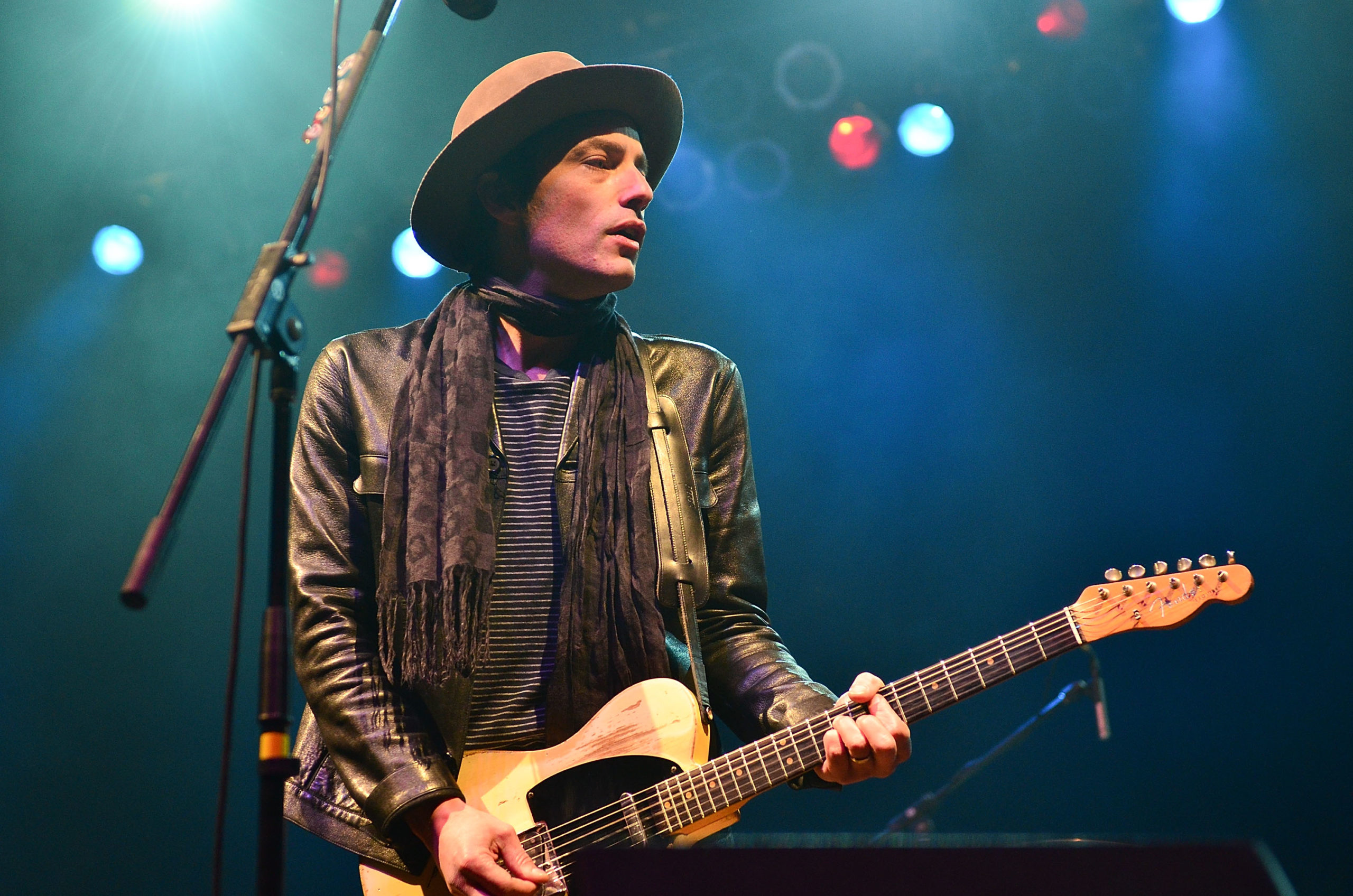
Allusions to Dylan’s lineage recur throughout The Wallflowers oeuvre, but they’re most apparent on 2000’s (Breach), the brilliant Bringing Down The Horse follow-up that features guests like Frank Black, Elvis Costello and Jon Brion. Dylan addresses the cynics on lead single “Sleepwalker,” a catchy rocker that reflects how Dylan felt at the height of his fame: like a dazed character drifting through his own life. “Maybe I could be the one they adore / That could be my reputation,” he sings. “It’s where I’m from that lets them think I’m a whore / I’m an educated virgin.”
On country-rocker “Hand Me Down,” Dylan sings self-effacingly about the perception of having failed to live up to his pedigree: “Now look at you, with your worn-out shoes / Living proof evolution’s through / We’re stuck with you / This revolution’s doomed.”
“I’ve Been Delivered” seems to find Dylan searching desperately to find his proper place. “So just keep on letting go / ‘Cause I might be close / To being delivered for the first time.”
“I could never explain to you what ‘I’ve Been Delivered’ is about,” Dylan reflects. “It’s about too much and bounces all over the place. It’s a big purging of a million different ideas that add up to one image … It’s actually about getting on the [lyrical] ride with me.”
Many critics hailed (Breach) as a worthy — if not superior — sequel to the band’s 1996 blockbuster. In their four-star review, Rolling Stone hailed The Wallflowers’ more “muscular” edge and lauded Dylan’s songs as both “incandescent” and “introspective.” (The magazine also put him on the cover for the second time.) Along with the accolades, the record also earned gold sales — but, unfortunately, it came and went before making too big a dent.
It’s possible momentum had waned in the four years since Bringing Down The Horse, which kept Dylan on the road for two and a half years, before exhaustion forced him to pull the tour’s plug. “It was just too much,” he says. “At a point, I lost focus. I felt like I was ready for new songs, but then you have to go home, write them, and make the record, and then it’s four years.”
What’s more, weeks ahead of its release, (Breach) was leaked to Napster, compromising its commercial potential. But Dylan still looks back fondly on the songs.
“I like that record a lot,” he says. “It’s more complicated than Bringing Down The Horse, and I think I started getting better as a songwriter. I think I’ve gotten better with every record, to be honest. Once you feel like you’re not, that’s probably when you should stop.”
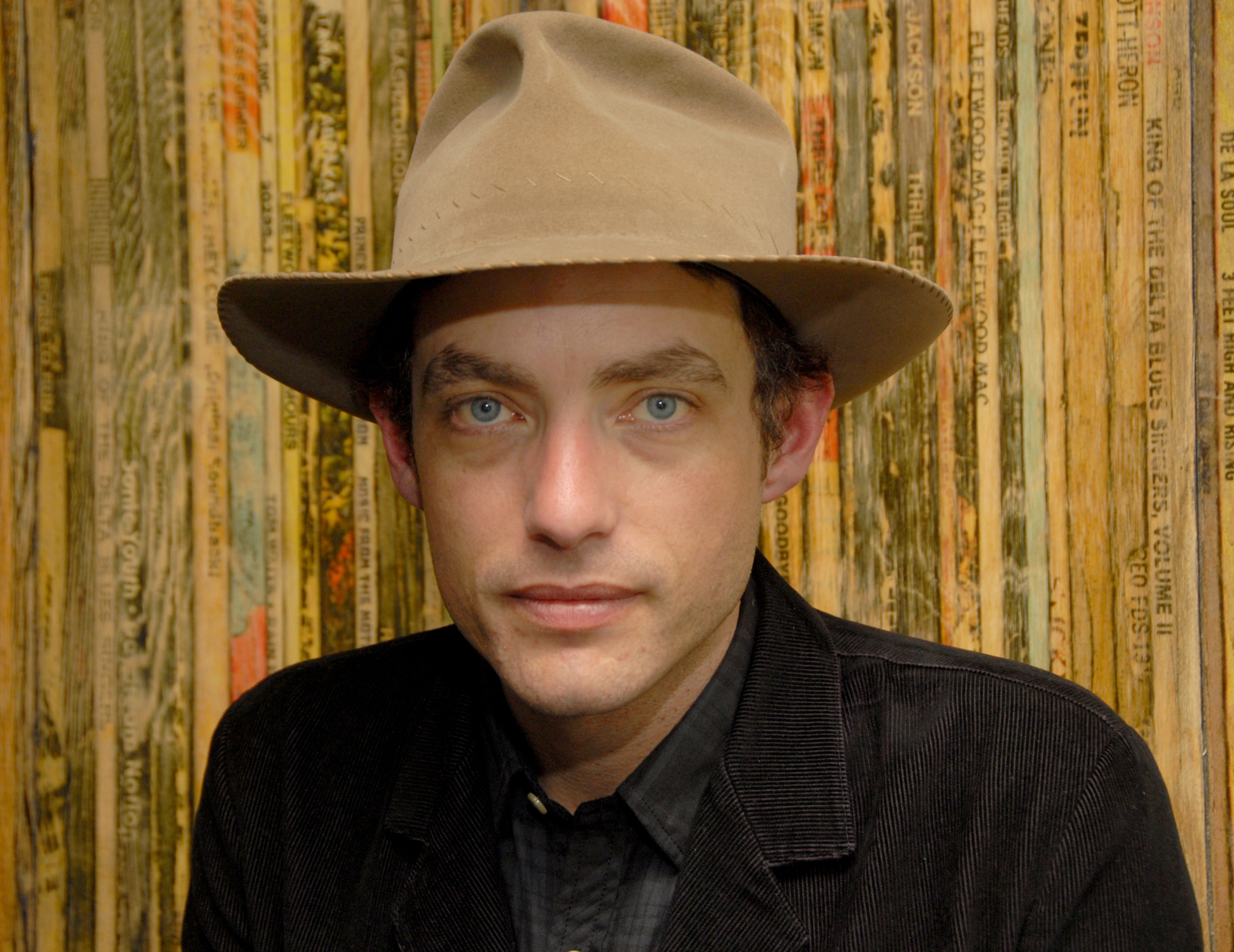
That quest for songwriting growth — not aiming to replicate The Wallflowers’ watershed moment — is what motivates Dylan. “I haven’t been striving to repeat Bringing Down The Horse,” he says. “You can’t repeat that year after year. It’s illogical. It’s a zeitgeist. It’s a wave you catch. When you have a successful record, it’s an opportunity. OK, you’re in the game, and now you can figure out what you want to do as a career.”
Dylan has continued to refine his craft, always staying receptive to inspiration. “Ideas come to you and nobody else at that time, so they’re worth chasing because of that,” he says. “You can’t go to work on a song if you don’t have a good idea, and you can work all day long on a song, but if you don’t have that hook, or that thing you’re working on that inspired you to start the song, you won’t get anywhere.”
Staying open sometimes means finding inspiration in previously untapped places. Until (Breach), Dylan didn’t write while touring — but on the road supporting the record, he penned a handful of tunes, recording demos in dressing rooms at venues. With material at the ready, he hit the recording studio more quickly than he had following previous records. The end result was 2002’s Red Letter Days, for which he invited Miller back into The Wallflowers’ fold — this time, in the role of producer (alongside Bill Appleberry).
At the time, many recording studios were switching over from analog to digital recording techniques, making use of the Pro Tools software — and all of its bells and whistles, including drum loops. Dylan saw the new technology as an opportunity to steer The Wallflowers away from the “rootsy” label. “It was never a term I liked very much,” he says. “I mean, I don’t mind it — everything gets labeled. But it brings up images of throwback music … It’s all rock and roll to me.”
Ultimately, Dylan feels the new production style didn’t do the band justice. “I don’t think, sonically, it suited us very well,“ he says. “Pro Tools was sort of a new toy at the time and, like a lot of bands, we didn’t use computers effectively, like we do today.”
Red Letter Days yielded lead single “When You’re On Top” (“That’s about as pop as I’m willing to get,” says Dylan) and the pulsating “Everybody Out Of The Water.” It also tucked away one of The Wallflowers’ all-time standout songs as a hidden track: “Empire In My Mind,” written for TV drama The Guardian (and serving as its theme for two seasons), is about grappling with a conflicted conscience — the poignancy accentuated by Dylan’s textured, raspy vocals.
“I wish I would / I wish I might,” sings Dylan, cleverly reflecting nursery rhyme “Star Light, Star Bright” to contrast childhood innocence with adult baggage. “To see a line tonight / Separating wrong from right.”
Three years after wishing upon a star, The Wallflowers worked with one: Powerhouse producer Brendan O’Brien helmed 2005’s Rebel, Sweetheart, helping Dylan create his sought-after wall of sound.
“I was looking for very grand. I wanted epic, stretched-out, large arrangements, like Phil Spector, or maybe even Captain Beefheart records,“ he says. “Often, when you’re recording, you want to keep things as concise as possible. But I was trying to stretch the songs out. Instead of cutting the fat, I wanted to do the opposite.”
The results almost matched Dylan’s lofty ambition. “The music became more dense than I’d expected,” he says. “It’s the record where I learned, after living with it, that if you can’t hear me, create space for my voice. It’s pretty tucked into the mixes. But I’ve always liked this record. I think the songs are consistent and strong.”
A jewel in The Wallflowers’ catalog from start to finish, Rebel, Sweetheart furnished beauties like the existential, melancholic “God Says Nothing Back” (a nod to W.H. Auden poem “If I Could Tell You”), the sweeping “Beautiful Side Of Somewhere” and the punchy “Here He Comes (Confessions Of A Drunken Marionette),” in which Dylan skillfully depicts a drunk and angry string puppet’s conflicted relationship with his narcissistic puppeteer at a bar on New Year’s Eve. “They sing ‘Auld Lang Syne,’” he sings. “And I’ve got mutiny on my mind.”
Rebel, Sweetheart temporarily sent The Wallflowers out on a high note — at least musically. But the band broke up by the end of the corresponding tour, because of steadily deteriorating relationships, resulting in their seven-year hiatus. “We limped along for whatever commitments were left and went our separate ways,” says Dylan.
In the meantime, Dylan flourished on his own: writing songs for soundtracks, making two critically acclaimed solo records, and touring.
By the time he made his 2008 solo debut, the Rick Rubin-produced Seeing Things, Dylan had grown more sophisticated — and personal — in his songwriting. That intimacy is accented by the record’s starkness, comprising two acoustic guitars and Dylan’s vocals.
However, he says Seeing Things wasn’t intended to be acoustic. “I didn’t know if I was making demos or not, and at some point, it just turned into a record,” he says. “I am not unhappy about it, but I could have done so much more with that record.”
Rubin was not only his producer, but also Columbia Records’ co-chair, leaving Dylan feeling trapped during what he describes as an arduous eight-month recording process. “It’s a pickle when I realized the record wasn’t going where I thought it should go,” he says. “Who do you complain to when your producer is the head of the label? … It was a conflict of interest, to say the least.”
“In fairness, I don’t know how interested [Rubin] was in working with me,” Dylan adds. “He’d just gotten his job. Maybe he wasn’t that invested in me, but he should have stepped out of the way.”
Yet Dylan took his chances on another solo record, reuniting with Burnett on 2010’s Women + Country: a low-key masterpiece brimming with sharp wit and insights, enveloped within poetic Dust Bowl imagery. He affectionately calls the project “a record made in quicksand,” due to its consistent mid-tempo pace.
Dylan’s solo records have drawn a devoted following that regularly champions his “underrated” songwriting on social media. “I appreciate the intent [of that description], which means maybe you’re not being noticed as much as you should be, and everybody wants more notice,” he says. “But chances are not everyone’s going to hear you. They’re not commercial records. They’re more specific. But my records reach who they are meant to reach — the people who are meant to find them — and they mean a lot to them.”
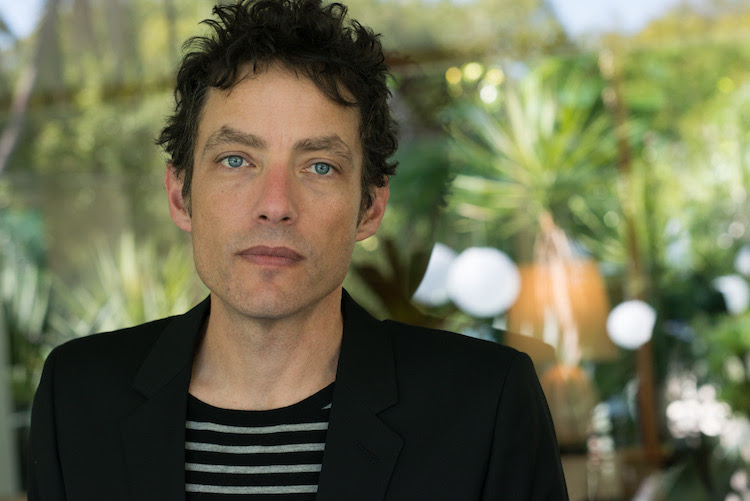
Wherever Dylan’s records land, they always come from the heart. But even the most sincere heart can retreat sometimes — a sentiment he explores on Exit Wounds’ opening track, the bluesy, Lynne-backed “Maybe Your Heart’s Not In It No More,” in which Dylan ponders his muse’s commitment. “It’s gone quiet / It’s gone cold / Acting like someone’s you don’t know,” he sings. “Used to rumble / Used to Roar / Whatever it’s doing, it didn’t before / Maybe your heart’s not in it no more.”
In the final verse, however, Dylan finds resolution: “I’ll carry you now / I’ll take us both / Down whatever’s left of this road.”
Perseverance, as a motif, spans Dylan’s entire catalog, running in parallel with his career. The nine years since the last album might have felt like an eternity for fans, but it seems to have been just long enough for Dylan. Ultimately, he ended up with his favorite Wallflowers record to date.
“It came from a genuine place,” he says. “I wrote and recorded it without anyone else in mind, and knowing I don’t have to make records anymore. The record business is unrecognizable. I can tour without a record. So there’s nothing to be gained or lost, other than I want to be doing it. On this record, there’s no treadmill. I’m off the ride.”
Like anybody with a storied music career, Dylan has accumulated exit wounds over the years. Incredibly, he doesn’t seem to have sustained any permanent scars.

